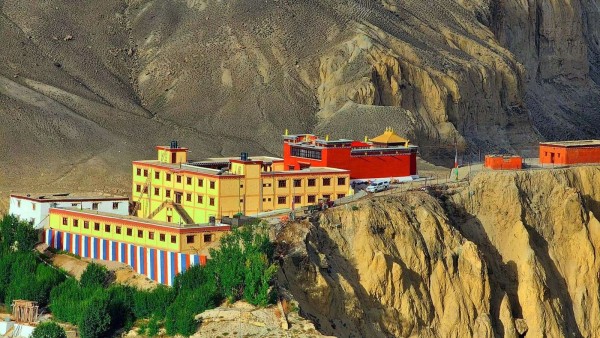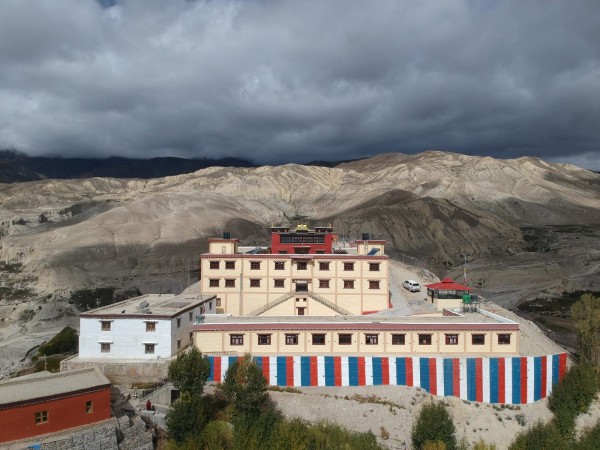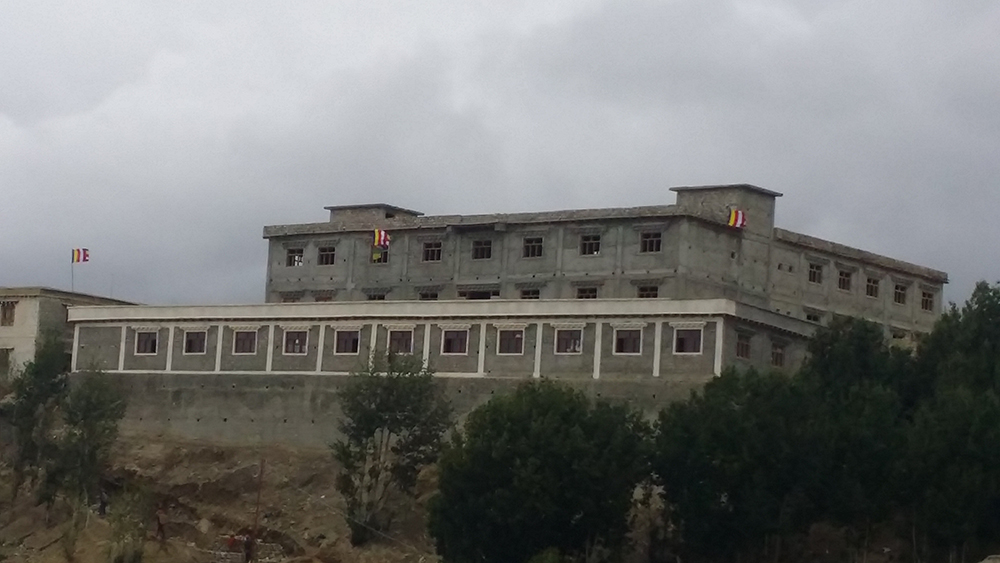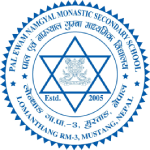
History of Namgyal Monastery


Pal Ewam Namgyal Choedhe Thupten Dhargyeling Monastery is one of the ancient, historical monasteries in Upper Mustang, where masses of ardent devotees inevitably visited to worship and practise traditional ritual performances. This monastery is in the northern range of Nepal near the Tibet border, at an altitude of 3,850 meters from sea level.
Before Ngorchen’s (1382–1456) visit, a powerful household during Gunthang's rule typically called Zhangpa ( ཞང་པ། ) had authority over the Namgyal monastery. There were also four other monasteries besides Namgyal Monastery. King Amapal (b. 1388, First King of Mustang) and his lineage had built Dakar Thekchenling, Rishing Domsumling, and Jampa Shedupling around Khachoe Labrang (Currently, a ruin on a hill near Namgyal village). Drungpa Choje Kunga Chokdrub (A son of the elite and went to Tibet at the age of 22 and later established that monastery) built Phuphak Samtenling Monstery.
After the gradual diminution of the powerful household called Zhangpa ( ཞང་པ། ), King Amapal (b. 1388, First King of Mustang) invited the supreme master Ngorchen Kunga Sangpo to Mustang. Ngorchen Kunga Sangpo refurbished and expanded Namgyal Monastery. He enhanced the monastery where mostly Sutrayana was practised for a long time. The monastery became a shelter for more than a thousand monks. Since then, the Namgyal monastery became the seat of Ngor tradition. Khenpo Jamyang Sherab Gyatso (1396–1474) was enthroned as the first Khenpo (Abbot) or seat holder of Pal Ewam Namgyal Choedhe Thupten Dhargyeling Monastery by Ngorchen Kunga Sangpo. Jamyang Sherab Gyatso was the closest and entrusted disciple of Ngorchen Kunga Sangpo at that time. From then, the tradition of an academic tour to Ngor Monastery, Tibet was started and continued till 1959.
Then respectively Penchen Sakya Chokden (1428–1507) and Lowo Khenchen Sonam Lhundup (1456–1532) became seat holders of the Monastery. During Lowo Khenchen Sonam Lhundup (1456–1532) on 6 June 1505, an earthquake estimated magnitude of 8.2 and 8.8 has occurred. That was one of the largest earthquakes in Nepalese history. There had been massive destructions. All the monasteries had to combine to protect the left tressures and traditions safely. Monasteries called Rishing Domsumling, Jampa Shedupling, and Phuphak Samtenling collaborated to Namgyal Choedhe Thupten Dhargyeling monastery. Dakar Thekchenling monastery had moved to Lo-manthang village. After the collaboration, there were four groups called Khangtsens ཁང་ཚན། (houses ) of monks. They all stayed under the same roof of Pal Ewam Namgyal Choedhe Thupten Dhargyeling Monastery.
Then again Jetsun kanga Drolchok (1507–1566) and Jetsun Kunga Palzang (1513–1595) became the seat holders of Namgyal Choedhe respectively. After Jetsun Kunga Palzang (1513–1595) the history of continued seat holders are not clear but the oral tradition speaks that the Khenpos (abbots) were sent from Ngor monastery, Tibet. From the late 19th century to the late 20th century, Lama Ludrup Rinpoche, Meme Yonten Sangpo, Gen Tusltrim Woser, Gen Ngawang Kunga, Khenpo Thokmey Choephel and Meme Dhondup became representative seat holders respectively.
The vanishing of Mustang's royal power on the Ngari side and war from Jumla in the 17th century affected the Monastery literally. Thus, the fame and active dharmic activities diminished from the late 19th century to the late 20th century. After 1959, the tradition of an academic tour to Tibet vanished. All the regular ritual traditions of the monastery declined. So, the number of monks begun to decrease in every Khangtsen ཁང་ཚན། (house). Thus, all Khangtsens ཁང་ཚན། (houses) were also diminished which led the monastery itself to diminish.
In 1962, His Eminence Chogye Trichen Rinpoche visited Namgyal Monastery and bestowed empowerment of the "twelve refining factors" (སྦྱོང་རྒྱུད་དཀྱིལ་འཁོར་བཅུ་གཉིས་ཀྱི་བཀའ་དབང་།). His Eminence Chogye Trichen Rinpoche visited Upper Mustang several times. His dharmic visits and spiritual performances maintained and flourished the traditions of the monastery once again.
In 1963, there had a conflict among monks regarding shrine holy objects, and monastery tressures. That internal conflict became the law case in which they had to fight a case against each other in presence of King Angon Tenzin Dadhul. From then Namgyal Sangha dispersed. That incident is one of the most miserable stories of the monastery.
In 2004, Venerable Khenpo Tsewang Rigzin was sent to Namgyal Choedhe Thupten Dhargyeling monastery with the kind spiritual guidance from His Holiness 41st Sakya Trizin Rinpoche and His Eminence Luding Khenchen Rinpoche and the humble request of Namgyal Monastic Sangha. He was enthroned a Khenpo (abbot) to maintain and preserve monastic traditions and ritual practices to flourish Buddha Dharma in Mustang. In 2005, he started Pal Ewam Namgyal Monastic School. In 2006, he built a school near the monastery in Namgyal, Mustang. In 2009, he built a monastic mobile school at Bhakunde, Pokhara. On 15 June 2011, he initiated Nunnery school in Trenkhar. Nunnery school was inaugurated on 9 August 2012 by the members of Altevette Onlus. Unfortunately, on 25 April 2015, a massive earthquake destroyed Namgyal Monastery badly. The roof collapsed and crashed into the shrine hall. All the sculptures were able to shift to the school building with the help of volunteers from nearby villages.
The sculptures assembled at Namgyal Choedhe carries great values and shreds of evidence of the history of Mustang and its close connections to the western Himalayas, the craftsmanship of the Kathmandu valley, and the Sakya tradition.
In 2016, he built the Nunnery school at Khapaudi, Pokhara. On 20 July 2015 Ven. Khenpo Khenrab Sangpo was introduced as the next Khenpo (abbot) or seat holder of Namgyal Monastery after Ver. Khenpo Tsewang Rigzin. Since then, Ven. Khenpo Khenrab Sangpo took the responsibility of both the monastic and nunnery school. In 2020 Ven. Khenpo Tsewang Rigzin built a retreat centre in Pokhara near Nunnery mobile school.

New monastic residence after earthquake

New shrine hall after earthquake
Great Scholars who visited Namgyal Choedhe Thupten Dhargyaling Monastery.
During the golden age, many great masters like Ngorchen Kunga Sangpo (Established Ngor Ewam), Jamyang Sherab Gyatso (Third seat holder of Ngor), Raton Yonten Palsang, Penchen Sakya Chokden (Established Serdogchen Monastery), Khenpo Yonten Choegyal, Minyak Panchen, Namgyal Daksang, Lowo Khenchen Sonam Lhundup (Thupchen’s Khenpo), Panchen Palden Tsumtrim, Drungpa Choje Kunga Chokdrub (Built Phuphak Samtenling Monstery), Jestun kanga Drolchok (24th Jonang Seat Holder, established Cholung Jangtse Retreat Center in Tibet), Shangpa (Kagyu Master) and Jetsun Kunga Palzang (1513–1595) (25th Jonang seat Holder) visited and practised Buddhism in Namgyal Choedhe Thupten Dhargyeling Monastery.
Many renowned scholars from Tibet like, Ngorchen Lhachok Senge visited and taught here extensively. Scholars from Mustang like Dakar Sempa Chenpo, contributed their generous efforts in teaching and many more dharma activities with support from the King of Mustang, the only patron of the monastery. Nyingma Masters like Jamyang Rinchen Gyaltsen, Ngari Panchen Pema Wagnyal visited here to study. Kagyu Master like Lama Kunsang Jalue and great Masters from Tibet like Ngorchen Konchok Lhundup visited Namgyal Chodhe.
Upper Mustang, Monastery, Risk !!!
Upper Mustang was a restricted demilitarized area until 1992, which makes it a very preserved region due to its relative isolation from the outside world. After 1992 Mustang was opened to foreigners but only with a special permit because it is still a conservation area under ACAP. But in the late 1970s, areas of Tibetan culture in India and Nepal were open to foreign visitors. The photographs of art objects began to exchange, purchase and theft of major artworks. Indeed, stories of monuments that have disappeared from private and monastic ownership abound across the Himalayas. Due to such threats, restrictions on photography in Mustang for the interiors of monasteries and temples were imposed. Monasteries of the Mustang are at risk of such activities and the natural disasters of climate change of the 21st century.
